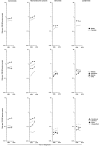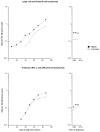Small intestinal cancer: a population-based study of incidence and survival patterns in the United States, 1992 to 2006
- PMID: 20647399
- PMCID: PMC2919612
- DOI: 10.1158/1055-9965.EPI-10-0328
Small intestinal cancer: a population-based study of incidence and survival patterns in the United States, 1992 to 2006
Abstract
Background: The etiology of cancers of the small intestine is largely unknown. To gain insight into these rare malignancies, we evaluated contemporaneous incidence and survival patterns.
Methods: Using small intestine cancer data from 12 population-based registries of the Surveillance, Epidemiology and End Results Program, we calculated age-adjusted and age-specific incidence rates (IRs), IR ratios, and relative survival (RS) rates.
Results: In total, 10,945 small intestine cancers (IR = 2.10/100,000 person-years) were diagnosed during 1992 to 2006, including carcinomas (n = 3,412; IR = 0.66), neuroendocrine cancers (n = 4,315; IR = 0.83), sarcomas (n = 1,084; IR = 0.20), and lymphomas (n = 2,023, IR = 0.38). For all histologic groups, males had significantly higher IRs than females, and distinct age-specific gender patterns were limited to intermediate-/high-grade lymphomas. Neuroendocrine cancer rates varied significantly by race, with rates highest among blacks and lowest among Asians/Pacific Islanders. Carcinoma IRs were highest among blacks; sarcoma IRs were highest among Asians/Pacific Islanders; and lymphoma IRs were highest among whites. Age-specific IR patterns were similar across racial/ethnic groups. During 1992 to 2006, duodenal cancer IRs increased more markedly than those for other subsites. RS varied little by gender or race. Neuroendocrine cancers had the most favorable RS, and carcinomas had the least favorable. The greatest improvement in 5-year RS from 1992 to 1998 to 1999 to 2005 was observed for sarcomas and lymphomas.
Conclusions: Distinct small intestine cancer IR patterns according to histologic subtype suggest different underlying etiologies and/or disease biology, with susceptibility varying by gender, racial/ethnic groups, and subsite. Temporal patterns support a possible role for diagnostic bias of duodenal cancers.
Impact: Future epidemiologic studies of small intestine cancer should consider histologic subtype by gender, race/ethnicity, and subsite.
(c)2010 AACR.
Figures



References
-
- Gabos S, Berkel J, Band P, Robson D, Whittaker H. Small bowel cancer in western Canada. Int J Epidemiol. 1993;22:198–206. - PubMed
-
- Neugut AI, Jacobson JS, Suh S, Mukherjee R, Arber N. The epidemiology of cancer of the small bowel. Cancer Epidemiol Biomarkers Prev. 1998;7:243–51. - PubMed
-
- Neugut AI, Santos J. The association between cancers of the small and large bowel. Cancer Epidemiol Biomarkers Prev. 1993;2:551–3. - PubMed
-
- Bilimoria KY, Bentrem DJ, Wayne JD, et al. Small bowel cancer in the United States: changes in epidemiology, treatment, and survival over the last 20 years. Ann Surg. 2009;249:63–71. - PubMed
Publication types
MeSH terms
Grants and funding
LinkOut - more resources
Full Text Sources
Medical

